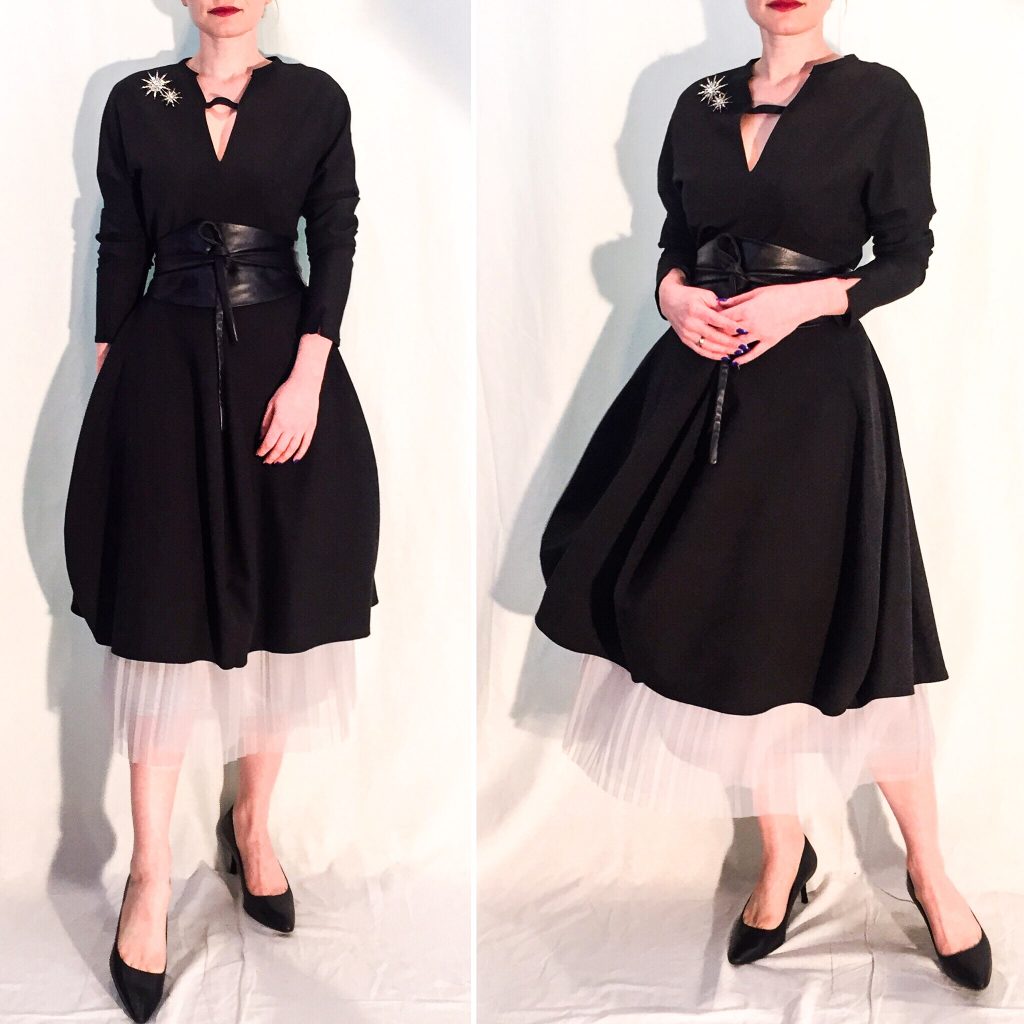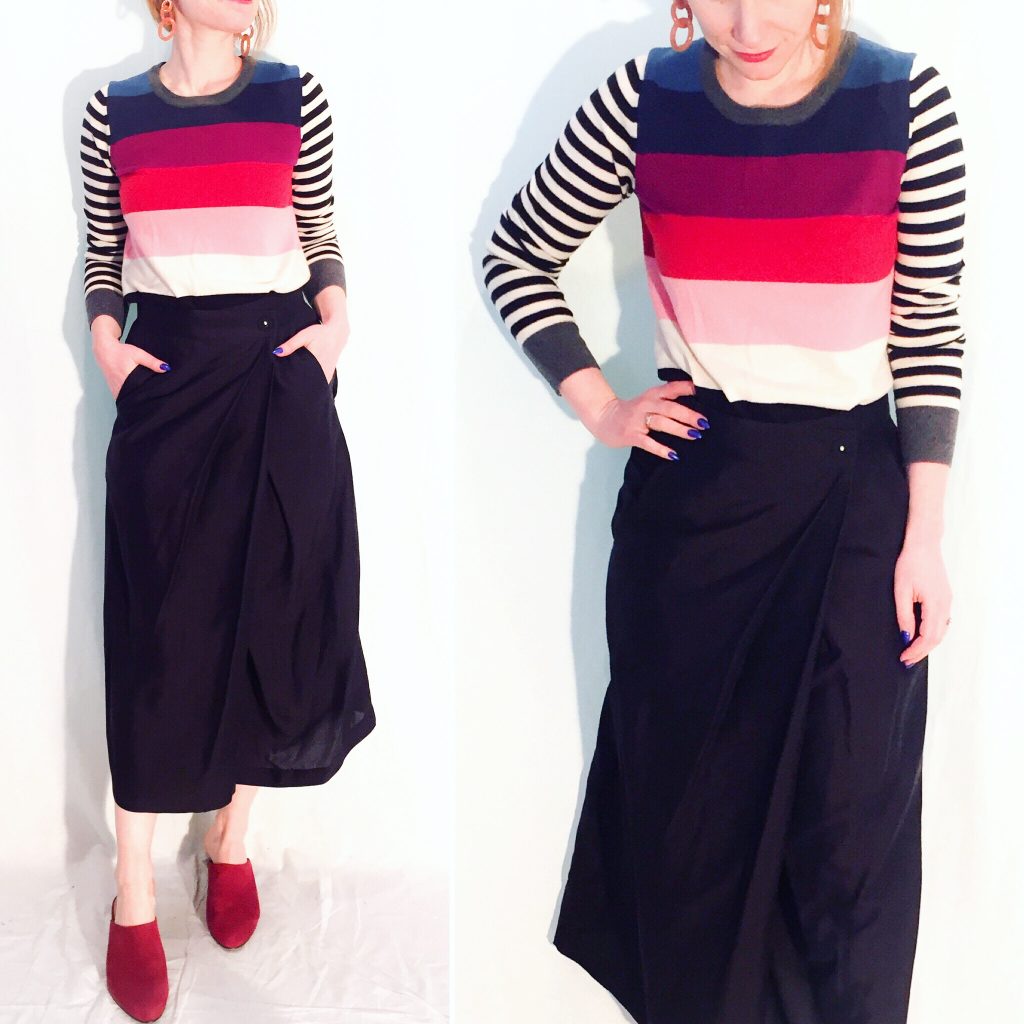Best of 2020

That’s right, I am calling it now: this outfit will be one of my favourites of the year. Maybe THE favourite. It may seem foolhardy to say that about something I wore on January 7, but I mean, just look at it. It’s pretty much perfect for me. It looks black in photos, but the Marie Saint Pierre dress is actually dark grey. It has some killer pleating which creates that fantastic bell shape. I added a light grey tulle skirt as a kind of petticoat because (a) I wanted to add length to the dress, and (b) visual interest. Rather than try to find a necklace that would compliment the unusual neckline, I decided to go with brooches; I am currently obsessed with star motifs, and these are statement-making without being gaudy. Last but not least, I decided to add a belt to further highlight the lines of the dress. It works. It all works.
Notes: Marie Saint Pierre dress (thrifted, $8.50); Everly skirt (thrifted, $8); brooches (Amazon, around $25); Greta Constantine x Danier belt (thrifted, $12); Cole Haan shoes (thrifted, $20).
The Splurge

I am constantly low-key stalking Dries Van Noten pieces on eBay; resale prices are typically high, so it requires a lot of patience to find a good deal on a piece I like. At the tail end of last year, I stumbled on this dress, which checks off a lot of boxes for me: midi length, sleeveless (easier to layer that way), interesting abstract pattern, nice colour palette. The price was pretty good (around $200CAD before shipping) and I was able to knock it down a bit further using the “Best Offer” option. Even better? I had saved up a good balance in my PayPal account from reselling clothes, so the dress cost me nothing out of pocket.
Side-note: I won’t lie, I still struggle with paying more than $100 on any single item of clothing, even if the money doesn’t come directly from my bottom line. But I have recently decided that, as thrifting supplies the bulk of my wardrobe and most of my clothing needs at a very reasonable cost, I am going to save up my reselling profits and use them on special “investment” pieces – i.e. things I need to pay up for. This would include pieces from my fave designers that are challenging to source through thrifting (Dries, Marni, Rick Owens, Issey Miyake, etc.) and expensive staples (like the MaxMara coat that I need to replace).
Back to the outfit: I kept things simple here with a black blazer as a topper, but I did add an extra pop of colour with the blue shoes. It works well with the yellow, I think. I don’t own a lot of yellow pieces but I like it in small doses and it does allow for some great colour combinations, like this one.
Notes: Dries Van Noten dress (eBay, $275); Theory blazer (thrifted, $13); J. Crew shoes (thrifted, $15).
Fun Friday

This is my take on casual Friday, sans denim. I know people tend to see a skirt and think “fancy” but it really isn’t. I mean, it takes the same amount of effort to put on a black skirt as it does jeans, and it goes with all the same things – like this sweater. Add a pair of mules, and you’re good to go. Easy, breezy, comfortable. I will say that my only 2020 resolution is to unapologetically embrace and express my inner oddball, so “extra AF” outfits will become more of the norm around here, hopefully, because that’s how my inner oddball likes to roll. An outfit like this tries to straddle the line between social expectations (casual Friday) and personal inclination (outfit with a twist).
Notes: Gap sweater (thrifted, $5); Crea Concept skirt (thrifted, $8); Eileen Fisher shoes (thrifted, $10).
Obligatory Witchy Lewk

Do I need to make this a recurring feature of these posts? I feel that maybe I do. Anyway, here’s the requisite “witchy” lewk of the week courtesy of a newly thrifted Oska dress (which is giving me real Issey Miyake/Junya Watanabe vibes) and my quickly-becoming-a-favourite embellished Blank NYC jacket. Note to self: find more star-print things. Maybe some earrings next?
Notes: Oska dress (thrifted, $8.50); BlankNYC jacket (retail, $63); Ecco boots (thrifted, $20).
